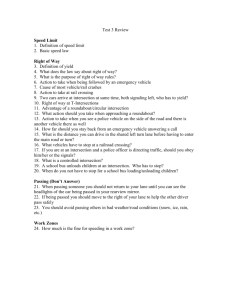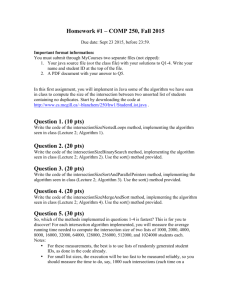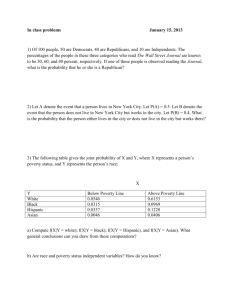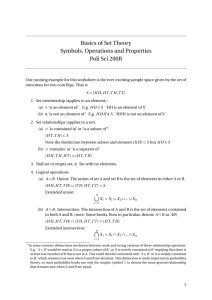Field data processing (In your analysis group for the second week)
advertisement
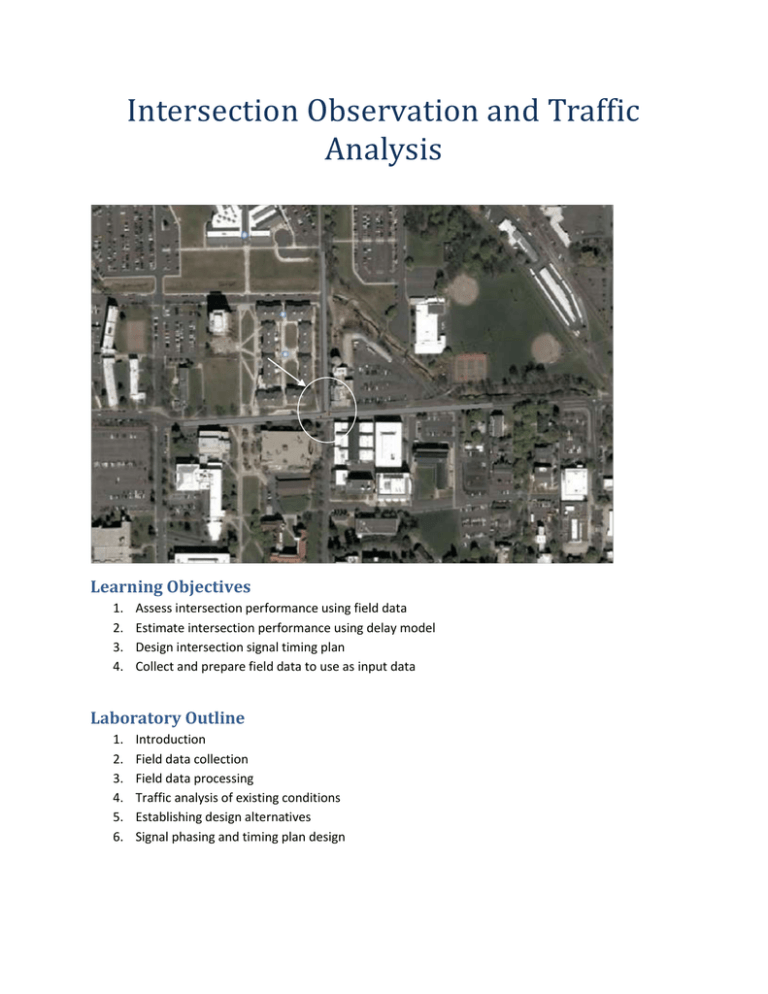
Intersection Observation and Traffic Analysis Learning Objectives 1. 2. 3. 4. Assess intersection performance using field data Estimate intersection performance using delay model Design intersection signal timing plan Collect and prepare field data to use as input data Laboratory Outline 1. 2. 3. 4. 5. 6. Introduction Field data collection Field data processing Traffic analysis of existing conditions Establishing design alternatives Signal phasing and timing plan design Introduction Up to this point, you have completed many homework problems related to the analysis and improvement of signalized intersection operations. To expand your experience in this area, this lab will require that you generalize your traffic analysis knowledge to a nearby intersection, where the methodology you use must be an adaptation of what you have learned, in order to fit the circumstance. As usual, instructor guidance is available, but this time it is in a way that encourages you and your classmates to arrive at the correct methodologies to use for data collection and analysis. The intersection of 6th Street and Line Street frequently experiences excessive queuing during a weekday when the University of Idaho is in session. University physical plant management has contacted you to conduct a study with the objective of determining how best to address the congestion problem. Two basic alternatives are available for you to analyze: no change, a non-traffic signal alternative, and a traffic signal. As always, the university is interested in student safety and the quality of an individual’s on-campus experience. So, management encourages you to think of additional features that may improve this experience with the existing intersection design or a modified one. Other universities have similar problems serving both crosswalk and vehicle traffic. It would be to your advantage to think of efforts that you have seen that safely and efficiently resolved the pedestrian-vehicle conflict and determine if this is applicable to the situation you are analyzing. Field Data Collection Explanation and Procedures (In your data collection group for the first week) Field data collection is one of the most important aspects of performing a traffic analysis and design activity. This makes sense, because the input data used to create and evaluate design alternatives are taken from the field data. As a result, if the field data are unreliable then so are the conclusions of your study. Data resulting from the field data collection are listed below. Make sure you understand why each of these items is important to your design and analysis. To help you acquire this understanding, we will discuss these items in class. This will help you make better decisions later when you are planning your data collection, during your data collection, and after data collection when you are processing the field data to arrive at the input data you need. 1. 2. 3. 4. 5. 6. 7. 8. Design hour (sometime between 4:00 and 5:30) Vehicle arrival volumes Vehicle service times Vehicle queue length Vehicle departure volumes (by turning movement) Pedestrian arrival volumes Pedestrian presence in crosswalk Free flow travel time 9. Intersection existing geometry 10. Adjacent land description Questions you need to answer before you start collecting the data: Answering the following questions well will help you successfully conduct your field data collection steps. Discuss them in your group and verify them with the instructor. 1. 2. 3. 4. 5. 6. 7. What do we need to do with the data? How should the data be aggregated? How do we collect the data and what tools are available to help with this? Do we need to synchronize our data collection? When do we collect the data? 4:00 to 5:30 PM, on any weekday other than Friday. Who will collect each item of the field data? How will the field data be delivered and who will gather the recorded data and deliver it to Dr. Dixon? The data must be delivered in one self-explanatory Excel file to Dr. Dixon. Names of students associated with each part of the data must be given (e.g., NB vehicle volumes arriving in queue Rikki Keegan, N-S pedestrian arrivalsSean Brady,…etc.) to assign lab grades for data collection) Field data processing (In your analysis group for the second week) After you have collected the field data, you need to process it to arrive at the items listed below. As with the field data collection, your experience in previous labs will also help with field data processing. For the sake of consistency and communication ease, all of your processed field data should be stored in an Excel file. 1. Vehicle and pedestrian hourly arrival flow rates, by turning movement (Which aggregation interval should you use? Is it necessary to use a PHF? How can you get turning movement arrival flow rates from the collected data?) 2. Service times for vehicles (How should you do this? Is it the same all of the time?) 3. Percent of time crosswalk occupied (Why might you need this?) 4. Intersection and adjacent land schematic Traffic Analysis of Existing Design (In your analysis group for the second week) Your primary purpose for performing this step is to pinpoint intersection deficiencies. With your analysis group, determine the best approach that you should take to analyze the existing design. Keep in mind that you have learned several traffic analysis techniques that you might apply to this problem. Which technique is most applicable? You should be able to estimate delay for each lane and mode. Can you do this with all of the techniques? What assumptions must you make in order to do so? Are these assumptions reasonable? Analyzing existing design for existing traffic Apply your adopted analysis technique(s). How well is the intersection operating? Do the results make sense? Existing design evaluation Evaluate the intersection operations, given the analysis results that you just obtained. How should you evaluate the intersection traffic operations? When should you say the intersection design is deficient? What is the cause of this deficiency? How could the intersection design be changed to address this deficiency? Establishing Design Alternatives (In your lab report group for the second week) Based on your evaluation of the existing design, you can develop design alternatives to address the intersection design deficiencies. As an engineer, your challenge is to address these deficiencies in such a way that provides safe and efficient public service in a cost-effective way that meets the client’s goals. Develop at least two design alternatives with this in mind (in addition to the do-nothing alternative). One alternative must include the installation of a traffic signal. Signal Timing Plan Design (In your analysis group for the second week) Use the steps outlined in class to develop an effective signal phasing and timing plan. How will you serve pedestrians and vehicles safely and efficiently? How can you tell that your proposed design will likely serve them safely and efficiently? Signalized Intersection Traffic Analysis (In your analysis group for the second week) Recognizing that you cannot evaluate a signalized intersection in the same fashion as the existing design, how should you analyze it? How can you adapt the signalized intersection traffic analysis procedure you learned in class to this problem, where pedestrians may be a major concern? The outcome of this step is a formal description of how you will analyze signalized control in the next step. Analysis of Design Alternatives (In your analysis group for the second week) Perform the traffic analysis of the two additional design alternatives for existing traffic conditions. Compare the three alternatives to each other and develop the reasoning you would use to recommend your favored alternative to the U of I physical facilities management. Report Write-Up (In your analysis group for the second week) Document your efforts in the above outlined steps. Include in the text of your document a response to questions found in each of the steps. Do not respond in a list format, but one that resembles a report, where you are seamlessly discussing different aspects of the problem and your solution, touching on points of specific interest.
